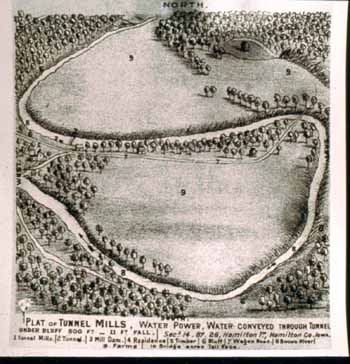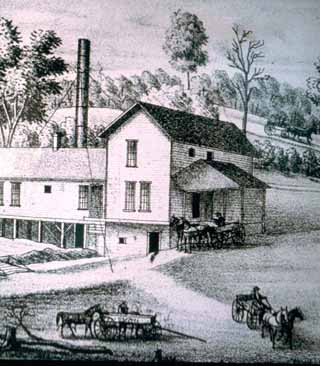Tunnel Mill
By Martin E. Nass
Transcribed for the IAGenWeb Project by Janelle Martin, with permission of Martin "Ed" Nass.
Robert "Bluejacket" Watson followed the Boone River north from its mouth
until he came to Section 14, Webster Township, where the river takes a sharp
horseshoe bend. Carefully measuring, he found that the river fell 6 1/2 feet as
it went around that bend, and the width between the upper and lower curves
measured only about 450 feet. He decided that if he could tunnel through the
hill, he could then build a dam at the upper end another 4 1/2 feet high and put
in a gate to give him an 11-foot drop. This would be sufficient to turn a mill
wheel.

Exactly when he came to the area is a subject of dispute. Effie Kantor, MacKinlay
Kantor's mother, wrote about the mills along the Boone River for J. W. Lee in
his 1912 Hamilton County history book. She states that Watson built the mill in
the 1850's. Her sources were her father, Adam McKinlay, who was the miller at
Bone's Mill, and also her grandfather, Joseph Bone, who owned what is now called
Bell's Mill. But the fact that Watson's nickname was "Bluejacket" would indicate
that he served in the Civil War. He was a member of the 8th Regiment
of the Iowa Infantry, but he is not listed as joining the Union forces from
Hamilton County. A check of courthouse records revealed that Robert Watson
purchased 50 acres from three different owners in 1866, and the mill was put
into operation starting in 1867. To the writer, it seems highly unlikely that
Watson would have dug a tunnel on property that was not owned by him.
In any event, Watson's feat was remarkable. With one assistant, and using a
pocket compass and a level he dug through 400 feet of hillside. He dug halfway
from the south end and halfway from the north. He dug and placed the dirt on a
cart which was pulled from the tunnel by the assistant. The ceiling of the
tunnel was lined with 3-inch planks of oak and walnut. The sides were shored up
with 3 X 8 inch posts. The finished dimensions of the tunnel were 3 ft. high and
2 ft. 9 in. wide. The floor of the tunnel was not lined. He then constructed the
dam and gates through which he controlled the flow of water to the tunnel.
Watson operated the mill for one year as a saw mill to which he added corn
grinding. Then sold it to Lyman Perry for $6,000 on January 17, 1867. The dam
property was excluded from the sale. Perry operated the mill for one year, when
he was joined by his brother, Gilbert. They added wheat burrs to make flour. In
the first advertisement appearing in the Hamilton Freeman on Nov. 10, 1869, it
was announced "Tunnel Mill in Operation." It further stated that "the mill was
located nine miles south of Webster City and would do all kinds of grinding on
short notice. A stock of flour was offered for sale by the pound or ton." Lyman
sold out to his brother, Gilbert, on October 24, 1870.
In 1869 Watson moved further upstream and constructed another mill, named
Turbine Mill, on the river about 5 miles south of Webster City. This mill was
sold to five different owners until it was finally purchased by Lyman Perry in
1878. This mill was not a financial success and was torn down by A. D. Arthur.
Lyman Perry continued operating mills along the Boone. He purchased what we
now call Bell's Mill from Joseph Bone. This mill was another turbine mill with
two turbines. When the mill finally ceased operations, one of the wheels was
displayed in Bell's Mill Park and the other was moved to Bonebright Park.

Some farmers paid for the grinding, but most paid the Perrys with what was
called the "Miller's Toll." In the beginning the millers generally kept
one-eighth of the corn and wheat as their toll. Later, in the latter 1880's it
was changed to one-seventh. An attempt at Bone's Mill to change it to one-sixth
met with resistance and the local farmers formed a strike until it reverted to
one-seventh. This meant that the miller had wheat and cornmeal to sell. Perry
opened a small store in the mill, where local people could purchase flour, salt,
soda, and other staple goods. An article in the Hamilton Freeman in 1883
reports, "Tunnel store has a big trade now days, as it rightly deserves to have,
for it has a good looking clerk, a big proprietor, and gives good bargains."
Lyman Perry built a large house east of the mill, and Gilbert's family moved in
with them. The Perry home accommodated many farmers overnight while they waited
for the grinding of their grain. In 1884, Gilbert replaced the burr mill wheels
with a roller, which produced a finer grade of flour.
The Perry home had advanced features for its time. Lyman Perry tapped into a
spring and piped the water into the house, so his wife had running water all of
the time. He also constructed cob chutes into the kitchen. An outside bin was
filled with cobs, and Mrs. Perry opened a small gate in the wall to catch cobs
for her stove.
The Indians lived in the woods along the river and came to the mill to sell
their goods to the waiting farmers. The farmers would get their grinding done,
get supplies from the store, or get their mail. Nina Bishop related that her
mother told her of the Indians boiling sap to produce maple syrup to sell. Her
mother told her that sometimes the Indians cooked their game in the sap, hanging
it by leather straps to a stick across the kettle. Fish caught by the Indians
were offered for sale. Local farmers also brought in bags of coal which were
sold at the store. There were many coal mines along the banks of the river
nearby.
In April 1889, the tunnel collapsed, shutting down operation of the mill
until repairs could be made. The entire tunnel was relined, this time with a
floor as well as a ceiling.
It was customary for a rowboat to be left on the river bank so people could
cross as they did their business at the mill. School children also rowed across
from the mill to attend school at the Harmony Center School, which was about a
half-mile south of the mill. This school building has been moved to Bonebright
Park in Webster City.
On Nov. 4, 1889, the mill was destroyed by fire. Perry had been grinding
buckwheat all day and a hot box on the mill wheel bearing caused them to shut
down. The men worked to repair the bearing, which took until nearly midnight.
Satisfied that everything was repaired, the men returned to the Perry home to
sleep. Early in the morning, Solomon Dick, who lived south of the mill,
discovered light coming from the mill area. He hurried to the Perry home to
alert the family that the mill was on fire. It was too late for the men to put
the fire out. The entire mill and a very large stock of grain, flour, and other
goods were completely destroyed.
The post office was moved to the John N. Williams home, which was located
just west of the former mill. He was named postmaster on May 10, 1893. The name
of the post office remained Tunnel. Williams served until Oct. 31, 1897, when he
was succeeded by Hezekiah Fisher. The Tunnel Post Office was closed on Oct. 31,
1899, and all mail was then handled from the Homer Post Office.
Merl Williams, grandson of John N. Williams, related that as a child he and
other children played in the abandoned tunnel. Fearful that someone would be
hurt, his father, Carl, dynamited the tunnel at both ends. Today the major
portion of the tunnel remains buried as a silent reminder of the mill's history.
The Lon Crosby family now lives at the mill site. Their home is near the
location of the original Perry house, which has now been torn down.
|